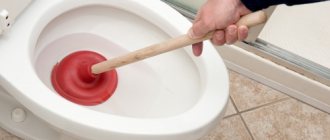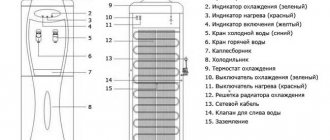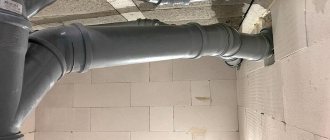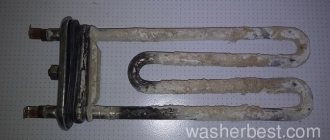Plumbing in every house or apartment plays a huge role in terms of comfort and convenience, and therefore the quality of life in general. Nowadays, the bathroom and toilet are the most technologically advanced rooms in the home, so not every person will be able to understand the intricacies and intricacies of the system. For example, many are interested in why water does not fill the toilet tank, what causes and breakdowns can lead to such a problem, and whether it is possible to deal with it yourself without calling a professional technician, whose services you will have to pay out of your own pocket.
Causes of problems with water intake
In a situation where water does not flow into the toilet tank, you need to pay attention to this problem and try to fix the breakdown as quickly as possible, otherwise the plumbing fixture can completely fail at any time and will need to be replaced.
In order not to pay money for the services of specialists or not to purchase new equipment, you can try to cope on your own with the fact that the toilet tank does not fill or it does not happen quickly enough. But first you need to find out why the breakdown occurred.
You should not immediately completely disassemble the device; you must first make sure that there is water in the water supply system. According to professionals, about 40% of water drainage problems occur due to the fact that it does not enter the device. First, you should find out whether there is a water supply in the house or riser, and only then look for the reasons why water is not filling the toilet tank.
When the system is full and the pressure in it is sufficient, but the device is not working, this indicates the presence of another type of breakdown. To be completely sure that everything is in order with the water supply, it would be best to talk about this topic with the neighbors living in the apartments above or below.
Problems with plumbing drainage occur when:
- The float is in the wrong position. This malfunction causes water to poorly fill into the toilet tank. Sometimes the toilet tank leaks for this reason, which is very unpleasant. This should be checked first, since the float can block and leak fluid in different positions.
- The water supply hose is clogged or damaged. Such malfunctions lead to a slow flow of water from the system, and sometimes to its complete shutdown.
- Sand or grains of rust have accumulated in the place where the pipe connects to the device or in the filter. This circumstance may explain why water is drawn slowly into the toilet tank. Typically, blockages occur as a result of repairs to utility lines.
- The exhaust valve is damaged, clogged or broken. This is one of the possible reasons for the occurrence of such a problem as water does not fill into the toilet tank.
Failure of plumbing equipment is caused by over-tightened structural fasteners - nuts, bolts and other elements. For this reason, you need to carefully check all connections, carefully turning them to make sure that everything is assembled securely and at the same time not overtightened.
It is necessary to make sure that there is no plaque or mucus on the plumbing components, since their presence may result in damage to the device.
Operating principle and design of the toilet
The installation system has a similar operating principle compared to the usual tanks. When you press the water release lever or button, the valve in the lower hole of the tank rises, after which the bowl is washed with water. When the tank is empty and the button is released, the valve returns to its original position under its own weight.
Then the automatic tank filling mechanism comes into operation. It consists of a shut-off valve that is connected to the water supply. The shut-off valve operates synchronously with the float.
When the tank is empty, the float moves down and opens the valve to fill the tank. Water arrives in the container and the float floats up in parallel. When it reaches a certain upper point, the water supply stops and the shut-off valve closes.
Today you can often find tanks with economical flushing, where there are two buttons, one of which allows you to use any part of the tank’s volume.
Float misalignment repair
If the toilet does not fill with water at all, this is unlikely to happen as a result of the float being misaligned. But in the case when it enters the system, but not in the required volume, then the float should be checked for its correct location.
To do this, you need to open the lid - under it you will see water, with a mechanism located in it and a lever, at the end of which a special buoy is attached - a float. It is this part of the device that is responsible for drawing water to the required level, after which it closes the inlet valve. It also happens that the toilet leaks after flushing; this may also be due to the float.
In case of misalignment, it begins to prematurely interrupt the supply of liquid, which ends in the inoperability of the device. The displacer is carefully placed by hand into the required position - after this, the operation of the system should be restored.
Consequences of inaction
If the drain begins to make noise, extraneous sounds are heard during operation, the tank fills slowly or the inlet valve does not work well - this is a serious reason to take up the tool. There is no need to wait until the problem gets worse. A non-working toilet is one thing, but if the water starts to overflow, even the neighbors below can feel the consequences.
A decrease in the capacity of the hose, a clogged valve - all this will quickly lead to the fact that the toilet cannot be used. The result of inaction can be excessive water consumption, failure of an expensive device, and in some cases, a serious accident.
Clogged water supply valve to the toilet tank
When the toilet tank does not fill with water, despite the fact that it is present in the water supply, the cause of the breakdown may be a clogged inlet valve. This occurs as a result of the accumulation of debris, sand, rust and other contaminants, including plaque and mucus.
It is advisable that the blockage be removed in a timely manner - such problems should be dealt with by regular cleaning and rinsing of the mechanism. Timely prevention will ensure that a situation does not arise when the toilet does not fill the tank with water.
The breakdown is repaired in a certain sequence:
- Turn off the liquid supply to the tank. Typically, houses and apartments have a common tap that can completely shut off the flow of water. It's being twisted.
- The underwater hose attached to the tank is unscrewed and removed. It is necessary to proceed with extreme caution, since sediment from the water supply system can make the disconnection process difficult.
- A visual inspection is carried out to find the place where the blockage has accumulated, after which it is cleared with a flexible steel wire.
- Release the water supply tap slightly so that the remaining debris and dirt are washed out under pressure.
After the blockage has been cleared, in order to complete the process of eliminating the problem associated with the fact that the drain tank does not take in water, all that remains is to carefully twist the entire structure in the reverse order, not forgetting the need to carefully tighten all the nuts, but, most importantly, not pull them over.
Then check the level of water intake and, if necessary, adjust it using the bend of the lever and the location of the float.
Replacing individual elements
Having purchased the necessary parts, they should be installed. To do this, it is recommended to follow the general algorithm of actions:
- The water supply is cut off.
- The buttons are removed, for which they are first carefully unscrewed.
- The top cover is removed.
- The water supply hose is disconnected.
- The drain column is removed. It is recommended to perform such actions in parts - the first element is turned at a right angle and removed, followed by the second.
- The fasteners holding the tank to the toilet are unscrewed.
- Having removed the tank, we place it on a surface convenient for performing work.
- Unscrew the nuts securing the valve and column, remove the remaining fittings.
- We assemble the new mechanism, in the reverse order we assemble the tank and install it.
It happens that after the work has been done, the tank still does not work well. In such situations, it is recommended to seek help from a professional who will inspect the structure, determine the cause and carry out repairs.
Damage to the supply hose
If you need to find out why water is not filling the toilet, be sure to check the underwater hose through which the liquid moves into the tank. This is a reason that property owners also often complain about.
After some time, the manufacturing materials and components for plumbing fixtures may wear out and, as a result, fail, and then such a problem as water not flowing into the toilet cannot be avoided.
The hose is replaced as follows:
- Depending on the design features of the water supply system, turn off the general water inlet valve to the housing or completely to the riser.
- Unscrew the supply hose and inspect it. If, during a visual inspection, damage is found in the form of cracks or holes, then it needs to be replaced, otherwise the problem of why the toilet does not draw water into the tank cannot be solved.
- When there are no visible imperfections on the hose, it is lowered into a previously prepared container and the general tap is slightly released. Leaks can be seen by the water that appears in them.
- The underwater hose is replaced with a new one, and you can use this plumbing equipment.
Sometimes, if water does not flow into the toilet flush cistern, you have to change the tee-joint, but to do this, they shut off the water supply not only to the riser, but to the entire house.
How does the mechanism of the toilet tank flush system work?
To correctly navigate the probable causes, you need to know the design features of the drainage system and understand how it works. Modern toilets consist of:
- drain tank;
- ceramic bowls;
- hose for water supply;
- valve responsible for release;
- lever for flushing;
- float device;
- overflow tubes;
- flap valve;
- flush gutters;
- siphon;
- water drainage.
This design option allows the toilet to collect and store the required amount of water, ensuring complete flushing of the owner’s waste.
Most elements are fragile, which leads to breakdowns that impair the operation of the entire system.
Read more in the article about the design of the toilet cistern flush mechanism.
Removing a blockage in the drain device
If the drain from which liquid pours into the toilet becomes clogged, problems also arise, but this does not affect the flow of water. It will enter the tank, raise the float to the required level, but the drain mechanism will not work.
Troubleshoot this way:
- remove the cover and disconnect the drain button;
- inspect the outlet valve from below, which opens when you press the water release button;
- If dirt is found, remove it by hand.
When the debris is not visually visible, the cause of the malfunction may be the tube connecting the tank to the plumbing. It should be remembered that mucus and plaque accumulate on the walls of the device and internal surfaces, which must be removed regularly.
Household chemicals, such as "Mole", for example, cope best with the cleaning task. They must be used with extreme caution and care, since the substances contained in their composition can harm the skin and mucous membranes of the respiratory tract. You must act in accordance with the attached instructions.
Step-by-step instruction
First, it is necessary to eliminate the incorrect position of the valve or float. These parts may move slightly. If there is a misalignment, you should remove the lid from the toilet tank and carefully adjust these elements by hand, putting them in place. Often, performing these simple steps is enough to fix the problem.
Adjusting the elements of the drain tank If this does not help, minor repairs will be required.
Other cases of breakdowns when water does not fill the tank
There are other situations when water does not flow into the toilet tank. Sometimes, when installing plumbing fixtures, the parts are twisted too tightly together, for this reason they cannot perform their functions correctly. In this case, all components should be disassembled, cleaned and reassembled.
Experts recommend: to avoid problems with poor water flow into the toilet tank, take preventive measures at least twice a year and thereby maintain the mechanism in good working order for a long time.
It should be remembered: if you neglect such a problem for a long time that water does not fill well into the toilet, it still will not resolve itself, but will only worsen.
Postponing the repair of plumbing equipment for an indefinite period of time always results in serious problems, which cannot always be eliminated. As a result, both the tank and the toilet will need to be replaced, which will require considerable financial costs.
In addition to the fact that a faulty plumbing fixture makes living conditions in the apartment less comfortable, it can completely break down at the most unexpected moment and flood the neighbors. Therefore, if breakdowns are detected, they should be repaired as quickly as possible.
Perhaps the reason why the toilet does not fill with water is that the inlet valve was initially defective, but this became evident during operation, especially when the water supply is not of high quality.
In addition, plaque accumulates on the surface of both the valve and the drain mechanism, which prevents them from operating correctly. For a home craftsman who has never done plumbing work, without professional knowledge, it will be difficult to figure out why water is drawn into the toilet tank slowly or does not flow at all. Perhaps the best solution would be to call a plumber.
Conclusions and useful video on the topic
The video will help you avoid mistakes when installing the installation and improve your understanding of the repair process.
Advice from experienced engineers will allow you to quickly find the cause of a malfunction in your toilet installation and promptly fix it. Study the principle of operation of the drain system, and you will be able to find the cause of the breakdown yourself.
What kind of breakdowns have you encountered while using your toilet installation? Tell us about your personal experience and ask questions in the comments to the article.
A wall-hung toilet, like its compact brother, can also break or start leaking. This situation is not at all a sign of impending expensive repair work with the collapse of the walls in the bathroom - repairing the installation for the toilet can cost a little money. Moreover, you can always try to eliminate the problem yourself.
We suggest that you familiarize yourself with the methods available to independent craftsmen for troubleshooting a wall-hung toilet. We list the main causes of breakdowns and the “symptoms” indicating their occurrence. Attention was paid to both the plumbing fixtures themselves, installed on the support frame, and the fittings of the flush cistern.
We supplemented the detailed diagnostics and scrupulously outlined methods for restoring the functionality of plumbing fixtures with visual illustrations and video tutorials.











